An Improved Bilinear Pooling Method for Image-Based Action Recognition

Auto-TLDR; An improved bilinear pooling method for image-based action recognition
Similar papers
Dual-Attention Guided Dropblock Module for Weakly Supervised Object Localization
Junhui Yin, Siqing Zhang, Dongliang Chang, Zhanyu Ma, Jun Guo

Auto-TLDR; Dual-Attention Guided Dropblock for Weakly Supervised Object Localization
Abstract Slides Poster Similar
Aggregating Object Features Based on Attention Weights for Fine-Grained Image Retrieval
Hongli Lin, Yongqi Song, Zixuan Zeng, Weisheng Wang

Auto-TLDR; DSAW: Unsupervised Dual-selection for Fine-Grained Image Retrieval
PSDNet: A Balanced Architecture of Accuracy and Parameters for Semantic Segmentation

Auto-TLDR; Pyramid Pooling Module with SE1Cblock and D2SUpsample Network (PSDNet)
Abstract Slides Poster Similar
Attention Pyramid Module for Scene Recognition
Zhinan Qiao, Xiaohui Yuan, Chengyuan Zhuang, Abolfazl Meyarian

Auto-TLDR; Attention Pyramid Module for Multi-Scale Scene Recognition
Abstract Slides Poster Similar
Multi-Order Feature Statistical Model for Fine-Grained Visual Categorization
Qingtao Wang, Ke Zhang, Shaoli Huang, Lianbo Zhang, Jin Fan

Auto-TLDR; Multi-Order Feature Statistical Method for Fine-Grained Visual Categorization
Abstract Slides Poster Similar
Channel-Wise Dense Connection Graph Convolutional Network for Skeleton-Based Action Recognition
Michael Lao Banteng, Zhiyong Wu

Auto-TLDR; Two-stream channel-wise dense connection GCN for human action recognition
Abstract Slides Poster Similar
A Grid-Based Representation for Human Action Recognition
Soufiane Lamghari, Guillaume-Alexandre Bilodeau, Nicolas Saunier

Auto-TLDR; GRAR: Grid-based Representation for Action Recognition in Videos
Abstract Slides Poster Similar
MFI: Multi-Range Feature Interchange for Video Action Recognition
Sikai Bai, Qi Wang, Xuelong Li

Auto-TLDR; Multi-range Feature Interchange Network for Action Recognition in Videos
Abstract Slides Poster Similar
Efficient-Receptive Field Block with Group Spatial Attention Mechanism for Object Detection
Jiacheng Zhang, Zhicheng Zhao, Fei Su

Auto-TLDR; E-RFB: Efficient-Receptive Field Block for Deep Neural Network for Object Detection
Abstract Slides Poster Similar
Global-Local Attention Network for Semantic Segmentation in Aerial Images
Minglong Li, Lianlei Shan, Weiqiang Wang

Auto-TLDR; GLANet: Global-Local Attention Network for Semantic Segmentation
Abstract Slides Poster Similar
DeepPear: Deep Pose Estimation and Action Recognition
Wen-Jiin Tsai, You-Ying Jhuang

Auto-TLDR; Human Action Recognition Using RGB Video Using 3D Human Pose and Appearance Features
Abstract Slides Poster Similar
Semantic Bilinear Pooling for Fine-Grained Recognition
Xinjie Li, Chun Yang, Song-Lu Chen, Chao Zhu, Xu-Cheng Yin
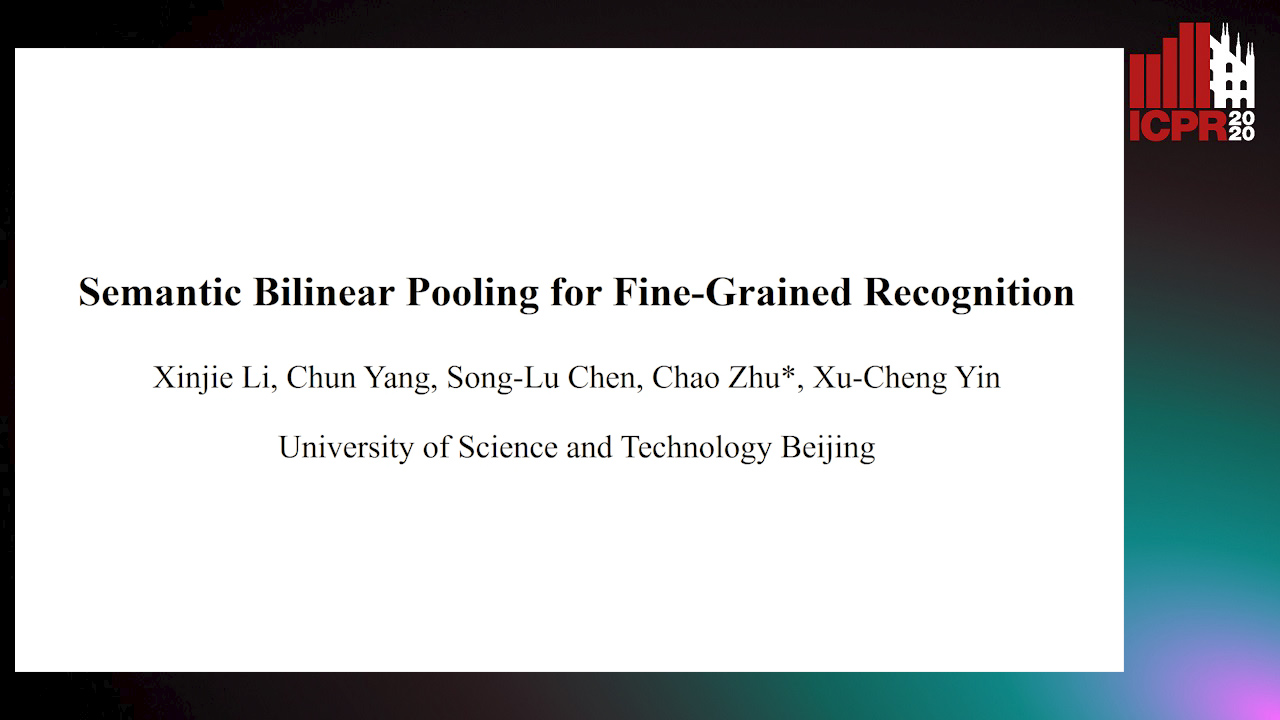
Auto-TLDR; Semantic bilinear pooling for fine-grained recognition with hierarchical label tree
Abstract Slides Poster Similar
A Novel Region of Interest Extraction Layer for Instance Segmentation
Leonardo Rossi, Akbar Karimi, Andrea Prati

Auto-TLDR; Generic RoI Extractor for Two-Stage Neural Network for Instance Segmentation
Abstract Slides Poster Similar
Attentive Hybrid Feature Based a Two-Step Fusion for Facial Expression Recognition
Jun Weng, Yang Yang, Zichang Tan, Zhen Lei

Auto-TLDR; Attentive Hybrid Architecture for Facial Expression Recognition
Abstract Slides Poster Similar
SCA Net: Sparse Channel Attention Module for Action Recognition
Hang Song, Yonghong Song, Yuanlin Zhang
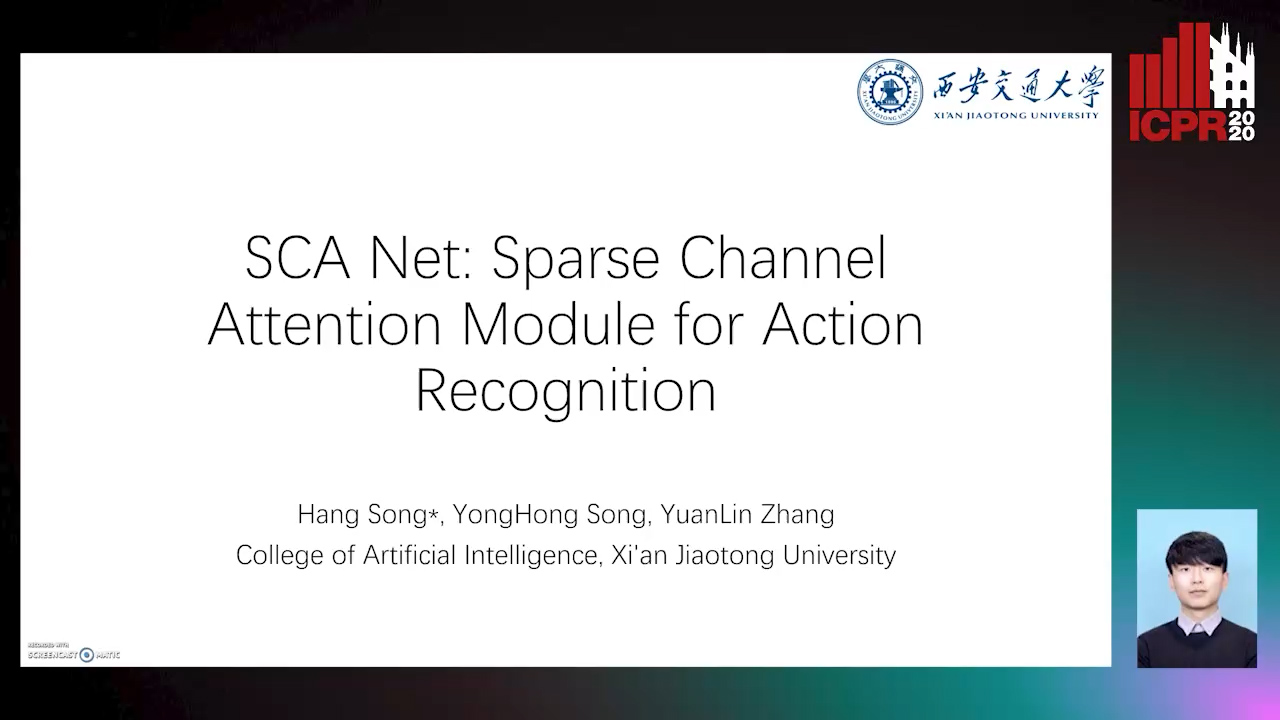
Auto-TLDR; SCA Net: Efficient Group Convolution for Sparse Channel Attention
Abstract Slides Poster Similar
Arbitrary Style Transfer with Parallel Self-Attention
Tiange Zhang, Ying Gao, Feng Gao, Lin Qi, Junyu Dong
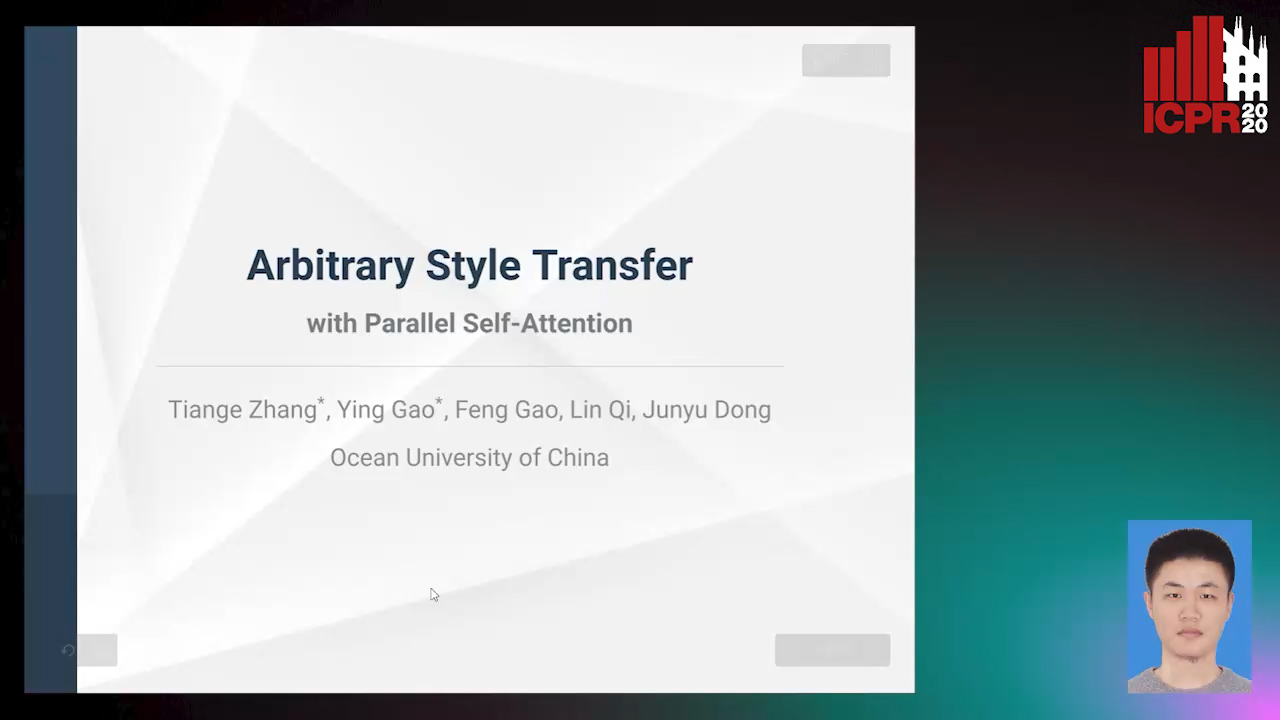
Auto-TLDR; Self-Attention-Based Arbitrary Style Transfer Using Adaptive Instance Normalization
Abstract Slides Poster Similar
Attention As Activation
Yimian Dai, Stefan Oehmcke, Fabian Gieseke, Yiquan Wu, Kobus Barnard

Auto-TLDR; Attentional Activation Units for Convolutional Networks
Multi-Scale Cascading Network with Compact Feature Learning for RGB-Infrared Person Re-Identification
Can Zhang, Hong Liu, Wei Guo, Mang Ye

Auto-TLDR; Multi-Scale Part-Aware Cascading for RGB-Infrared Person Re-identification
Abstract Slides Poster Similar
Second-Order Attention Guided Convolutional Activations for Visual Recognition
Shannan Chen, Qian Wang, Qiule Sun, Bin Liu, Jianxin Zhang, Qiang Zhang
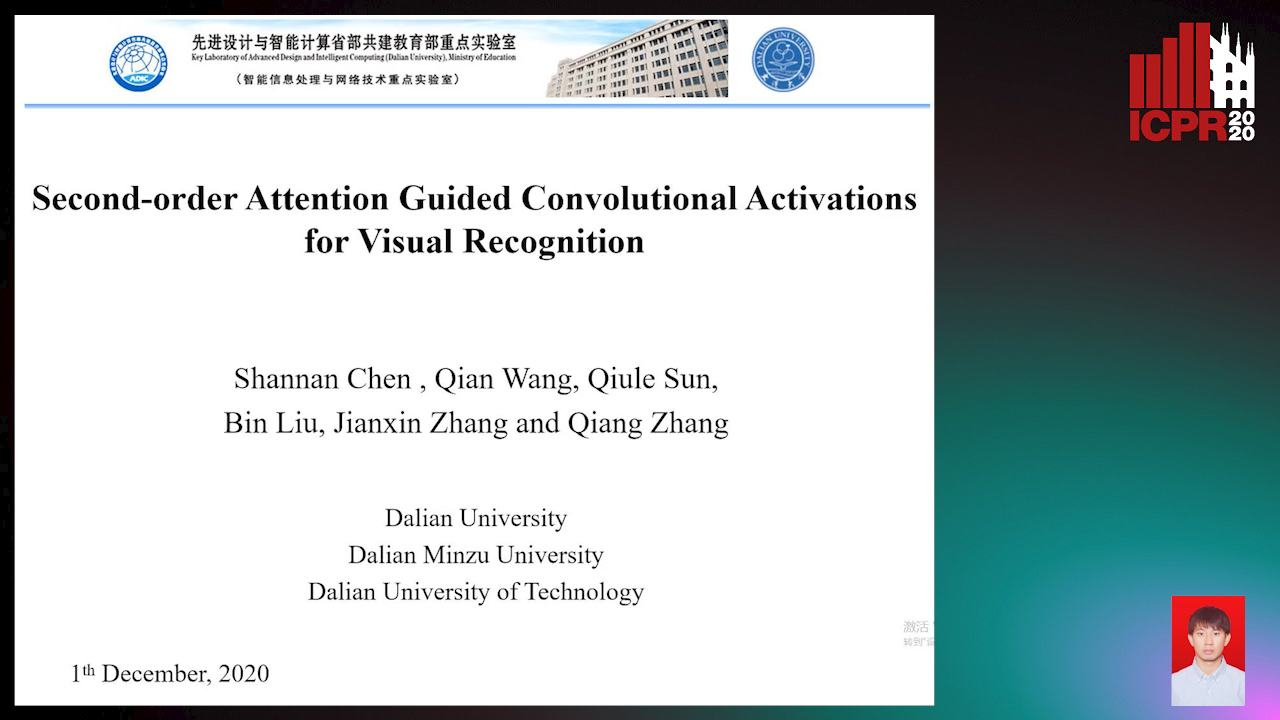
Auto-TLDR; Second-order Attention Guided Network for Convolutional Neural Networks for Visual Recognition
Abstract Slides Poster Similar
Selective Kernel and Motion-Emphasized Loss Based Attention-Guided Network for HDR Imaging of Dynamic Scenes
Yipeng Deng, Qin Liu, Takeshi Ikenaga
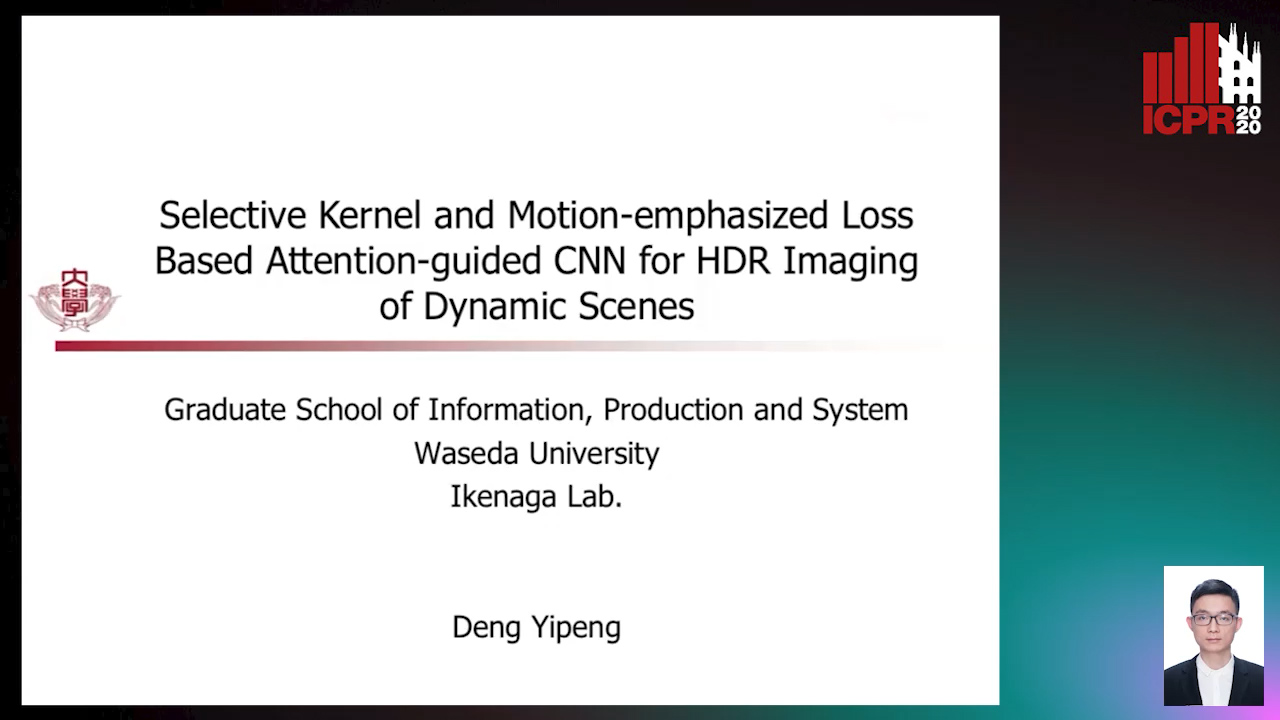
Auto-TLDR; SK-AHDRNet: A Deep Network with attention module and motion-emphasized loss function to produce ghost-free HDR images
Abstract Slides Poster Similar
Progressive Scene Segmentation Based on Self-Attention Mechanism
Yunyi Pan, Yuan Gan, Kun Liu, Yan Zhang

Auto-TLDR; Two-Stage Semantic Scene Segmentation with Self-Attention
Abstract Slides Poster Similar
Context-Aware Residual Module for Image Classification

Auto-TLDR; Context-Aware Residual Module for Image Classification
Abstract Slides Poster Similar
Flow-Guided Spatial Attention Tracking for Egocentric Activity Recognition

Auto-TLDR; flow-guided spatial attention tracking for egocentric activity recognition
Abstract Slides Poster Similar
ACRM: Attention Cascade R-CNN with Mix-NMS for Metallic Surface Defect Detection
Junting Fang, Xiaoyang Tan, Yuhui Wang

Auto-TLDR; Attention Cascade R-CNN with Mix Non-Maximum Suppression for Robust Metal Defect Detection
Abstract Slides Poster Similar
Two-Level Attention-Based Fusion Learning for RGB-D Face Recognition
Hardik Uppal, Alireza Sepas-Moghaddam, Michael Greenspan, Ali Etemad

Auto-TLDR; Fused RGB-D Facial Recognition using Attention-Aware Feature Fusion
Abstract Slides Poster Similar
3D Attention Mechanism for Fine-Grained Classification of Table Tennis Strokes Using a Twin Spatio-Temporal Convolutional Neural Networks
Pierre-Etienne Martin, Jenny Benois-Pineau, Renaud Péteri, Julien Morlier

Auto-TLDR; Attentional Blocks for Action Recognition in Table Tennis Strokes
Abstract Slides Poster Similar
Human-Centric Parsing Network for Human-Object Interaction Detection
Guanyu Chen, Chong Chen, Zhicheng Zhao, Fei Su
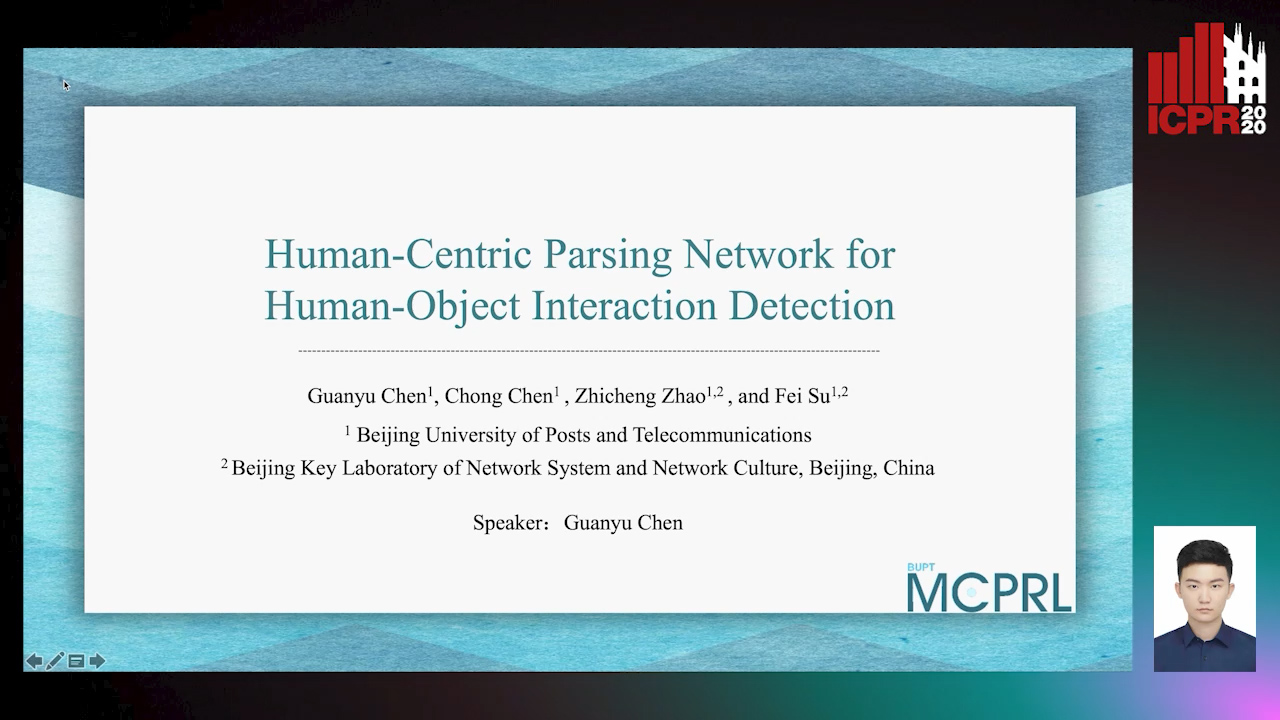
Auto-TLDR; Human-Centric Parsing Network for Human-Object Interactions Detection
Abstract Slides Poster Similar
Saliency Prediction on Omnidirectional Images with Brain-Like Shallow Neural Network
Zhu Dandan, Chen Yongqing, Min Xiongkuo, Zhao Defang, Zhu Yucheng, Zhou Qiangqiang, Yang Xiaokang, Tian Han
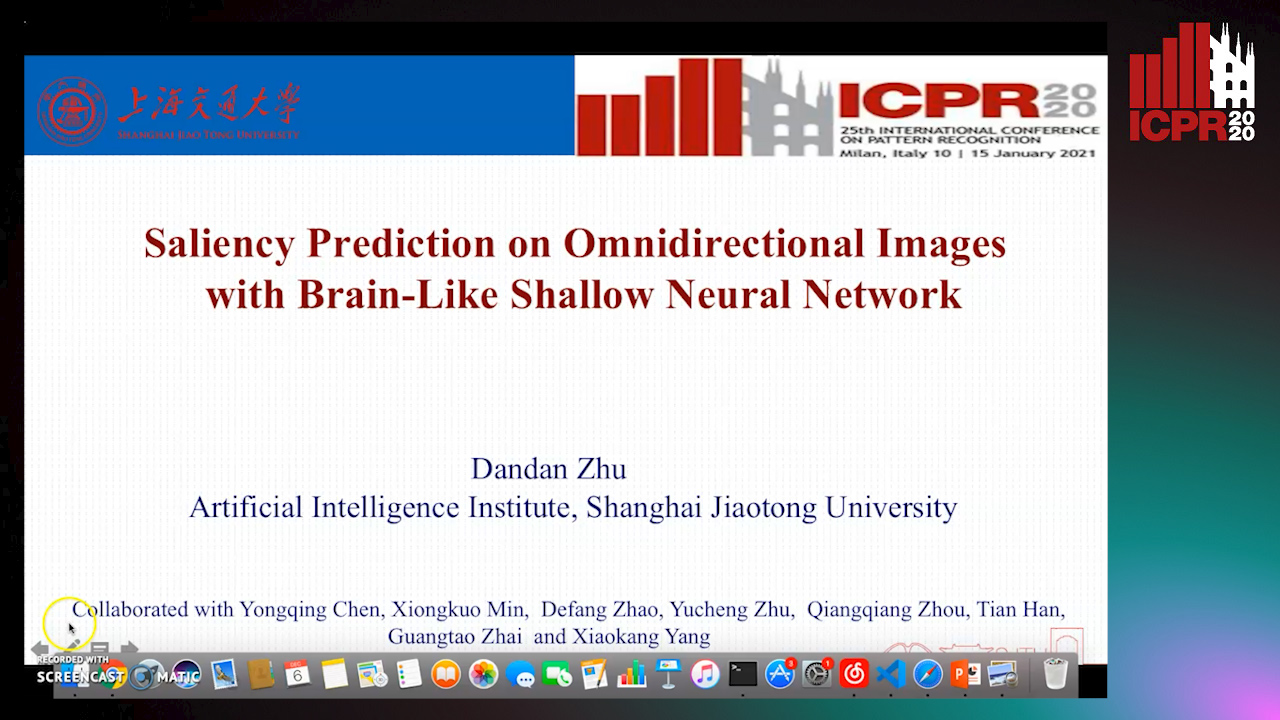
Auto-TLDR; A Brain-like Neural Network for Saliency Prediction of Head Fixations on Omnidirectional Images
Abstract Slides Poster Similar
Learnable Higher-Order Representation for Action Recognition

Auto-TLDR; Learningable Higher-Order Operations for Spatiotemporal Dynamics in Video Recognition
RSAN: Residual Subtraction and Attention Network for Single Image Super-Resolution
Shuo Wei, Xin Sun, Haoran Zhao, Junyu Dong

Auto-TLDR; RSAN: Residual subtraction and attention network for super-resolution
Self and Channel Attention Network for Person Re-Identification
Asad Munir, Niki Martinel, Christian Micheloni

Auto-TLDR; SCAN: Self and Channel Attention Network for Person Re-identification
Abstract Slides Poster Similar
Accurate Cell Segmentation in Digital Pathology Images Via Attention Enforced Networks
Zeyi Yao, Kaiqi Li, Guanhong Zhang, Yiwen Luo, Xiaoguang Zhou, Muyi Sun

Auto-TLDR; AENet: Attention Enforced Network for Automatic Cell Segmentation
Abstract Slides Poster Similar
Free-Form Image Inpainting Via Contrastive Attention Network
Xin Ma, Xiaoqiang Zhou, Huaibo Huang, Zhenhua Chai, Xiaolin Wei, Ran He

Auto-TLDR; Self-supervised Siamese inference for image inpainting
Spatial-Related and Scale-Aware Network for Crowd Counting
Lei Li, Yuan Dong, Hongliang Bai

Auto-TLDR; Spatial Attention for Crowd Counting
Abstract Slides Poster Similar
Self-Selective Context for Interaction Recognition
Kilickaya Kilickaya, Noureldien Hussein, Efstratios Gavves, Arnold Smeulders
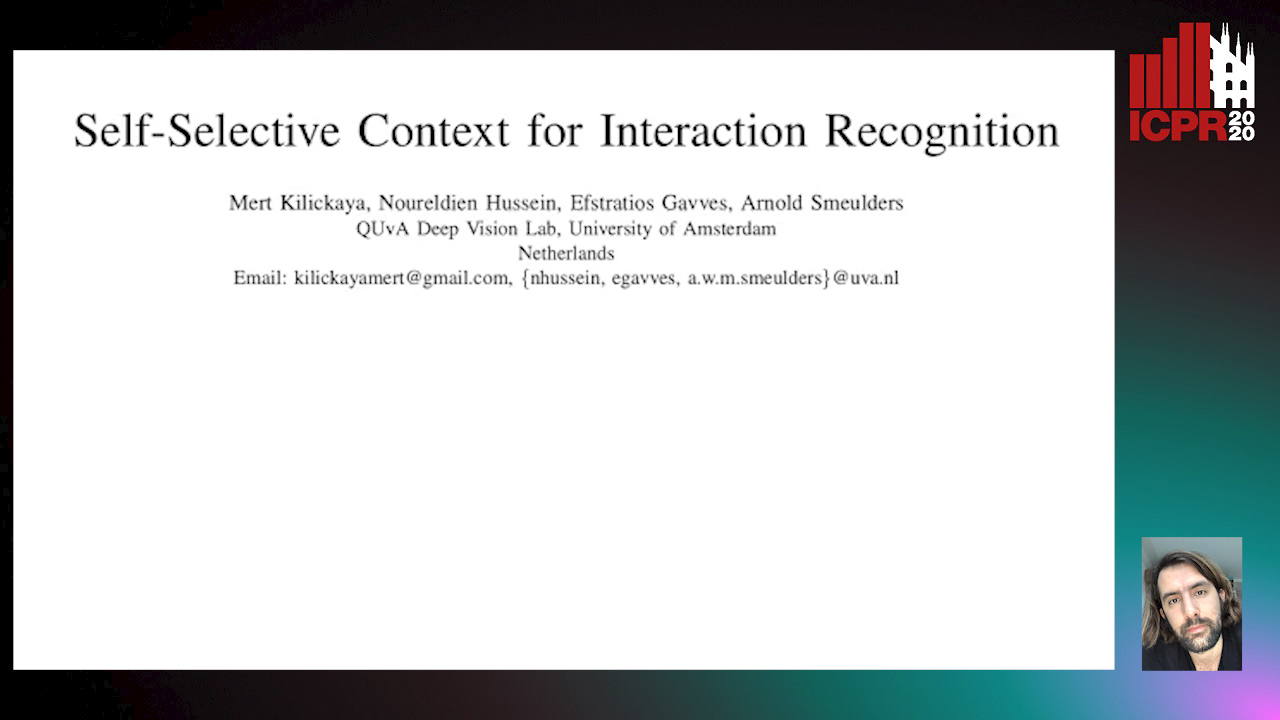
Auto-TLDR; Self-Selective Context for Human-Object Interaction Recognition
Abstract Slides Poster Similar
Multi-Scale Residual Pyramid Attention Network for Monocular Depth Estimation
Jing Liu, Xiaona Zhang, Zhaoxin Li, Tianlu Mao

Auto-TLDR; Multi-scale Residual Pyramid Attention Network for Monocular Depth Estimation
Abstract Slides Poster Similar
Skin Lesion Classification Using Weakly-Supervised Fine-Grained Method
Xi Xue, Sei-Ichiro Kamata, Daming Luo
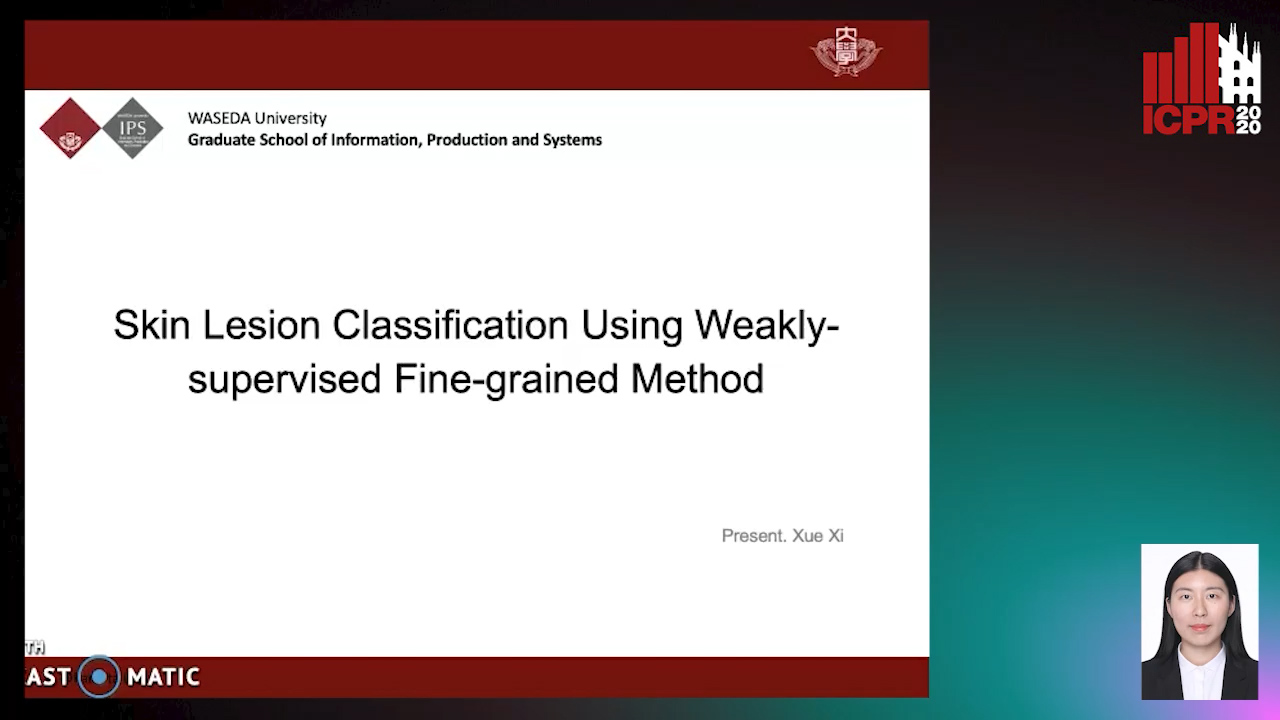
Auto-TLDR; Different Region proposal module for skin lesion classification
Abstract Slides Poster Similar
A Multi-Task Neural Network for Action Recognition with 3D Key-Points
Rongxiao Tang, Wang Luyang, Zhenhua Guo

Auto-TLDR; Multi-task Neural Network for Action Recognition and 3D Human Pose Estimation
Abstract Slides Poster Similar
Attention-Based Selection Strategy for Weakly Supervised Object Localization

Auto-TLDR; An Attention-based Selection Strategy for Weakly Supervised Object Localization
Abstract Slides Poster Similar
Real-Time Semantic Segmentation Via Region and Pixel Context Network
Yajun Li, Yazhou Liu, Quansen Sun

Auto-TLDR; A Dual Context Network for Real-Time Semantic Segmentation
Abstract Slides Poster Similar
SAT-Net: Self-Attention and Temporal Fusion for Facial Action Unit Detection
Zhihua Li, Zheng Zhang, Lijun Yin

Auto-TLDR; Temporal Fusion and Self-Attention Network for Facial Action Unit Detection
Abstract Slides Poster Similar
EDD-Net: An Efficient Defect Detection Network
Tianyu Guo, Linlin Zhang, Runwei Ding, Ge Yang
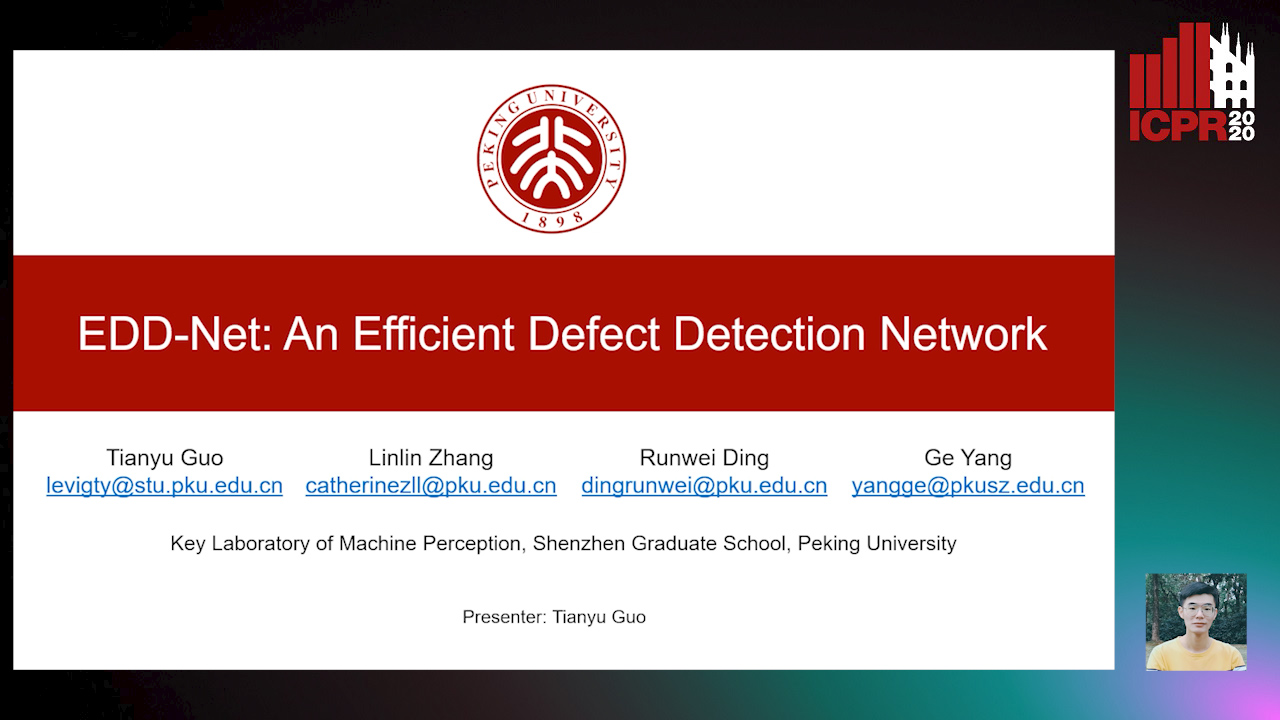
Auto-TLDR; EfficientNet: Efficient Network for Mobile Phone Surface defect Detection
Abstract Slides Poster Similar
Pose-Aware Multi-Feature Fusion Network for Driver Distraction Recognition
Mingyan Wu, Xi Zhang, Linlin Shen, Hang Yu
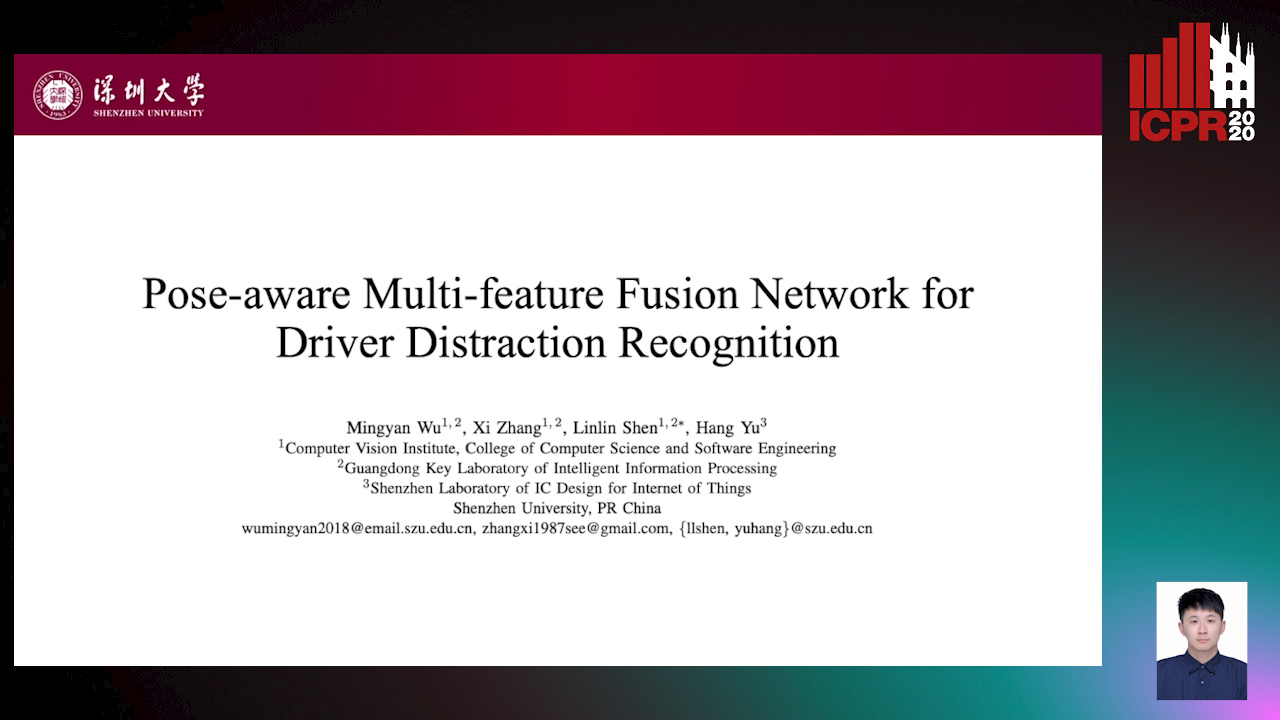
Auto-TLDR; Multi-Feature Fusion Network for Distracted Driving Detection using Pose Estimation
Abstract Slides Poster Similar
Local Attention and Global Representation Collaborating for Fine-Grained Classification
He Zhang, Yunming Bai, Hui Zhang, Jing Liu, Xingguang Li, Zhaofeng He
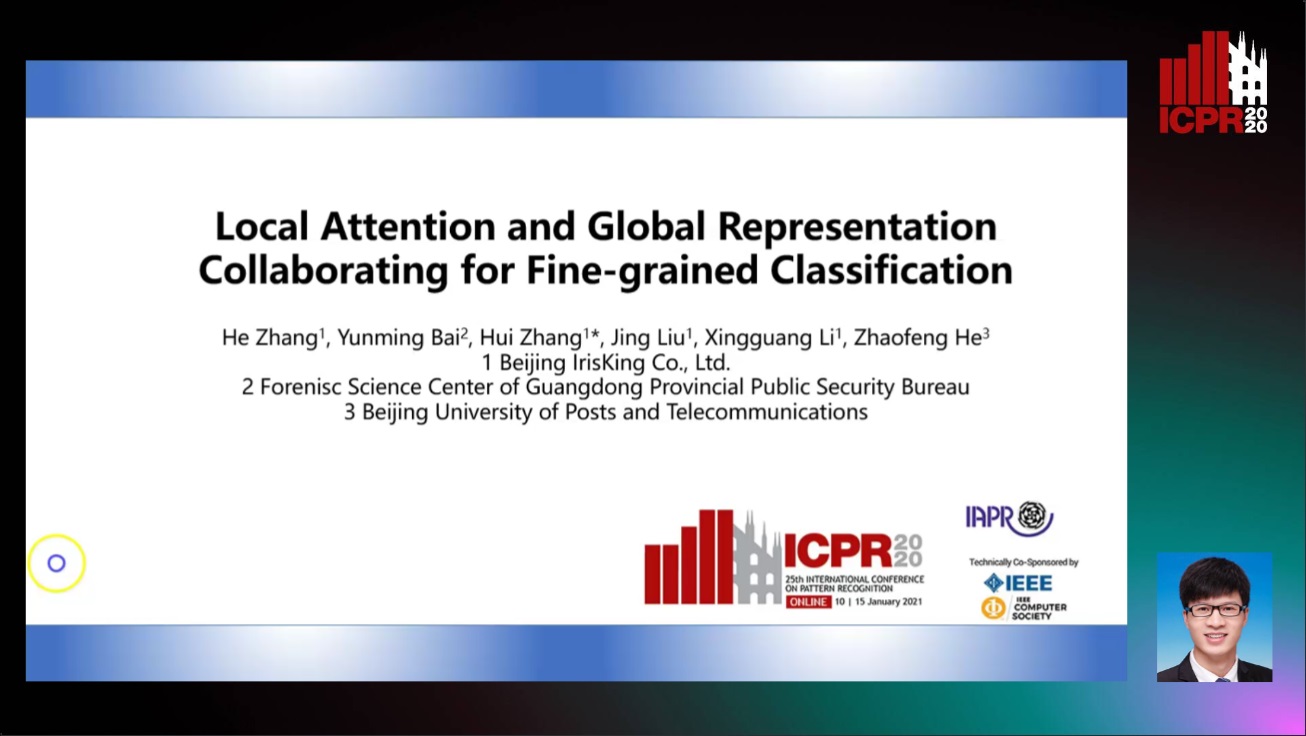
Auto-TLDR; Weighted Region Network for Cosmetic Contact Lenses Detection
Abstract Slides Poster Similar
Face Anti-Spoofing Using Spatial Pyramid Pooling
Lei Shi, Zhuo Zhou, Zhenhua Guo

Auto-TLDR; Spatial Pyramid Pooling for Face Anti-Spoofing
Abstract Slides Poster Similar
DARN: Deep Attentive Refinement Network for Liver Tumor Segmentation from 3D CT Volume
Yao Zhang, Jiang Tian, Cheng Zhong, Yang Zhang, Zhongchao Shi, Zhiqiang He

Auto-TLDR; Deep Attentive Refinement Network for Liver Tumor Segmentation from 3D Computed Tomography Using Multi-Level Features
Abstract Slides Poster Similar
Adaptive Feature Fusion Network for Gaze Tracking in Mobile Tablets
Yiwei Bao, Yihua Cheng, Yunfei Liu, Feng Lu

Auto-TLDR; Adaptive Feature Fusion Network for Multi-stream Gaze Estimation in Mobile Tablets
Abstract Slides Poster Similar
Attention-Oriented Action Recognition for Real-Time Human-Robot Interaction
Ziyang Song, Ziyi Yin, Zejian Yuan, Chong Zhang, Wanchao Chi, Yonggen Ling, Shenghao Zhang

Auto-TLDR; Attention-Oriented Multi-Level Network for Action Recognition in Interaction Scenes
Abstract Slides Poster Similar